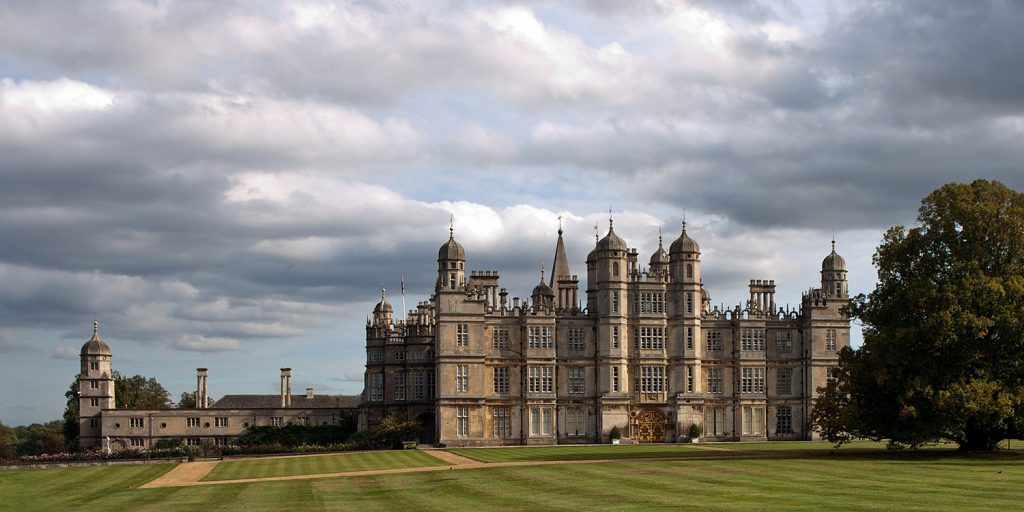I recently had the amazing opportunity to visit the momentous and hugely grand Burghley House. To say that the experience was merely educational and interesting would be an understatement.
The entire place is stooped in great history. And what’s more warming and enlightening is that the staff there, guides and administrative assistants, take immense pride in their surroundings. They are as equally in awe of Burghley as you are. And the emotion they show is renewed with every face that steps inside.
The image of Burghley House that a lot of us share – the two statuesque towers standing squarely at the entrance, with a glorious gold entranceway and huge blocks of limestone carrying your sight away at either side, all set on pristine flora and perfectly maintained grass – is merely a façade. Rather it has a more intimate and glowing underside that can only be experienced upon exploring its bowels.
A fascinating kitchen
One of the first rooms I visited was the old kitchen, built between 1555 and 1587 for Sir William Cecil, Lord High Treasurer to Queen Elizabeth I. This was perhaps the most historically captivating room because of its remarkable similarity to how it looked originally. It is often easy to negate the existence of earlier times, and of the different interests and habits of yesteryear. Yet one immediately remembers this when casting one’s eye over the rather macabre-looking, but still fascinating, array of turtle skulls lining the wall above the cooking area in the kitchen. It’s an ancient reminder of a time before people questioned the morality of the consumption of tropical animals. It also serves as a note that British aristocracy frequently passed through Burghley’s inviting, yet austere, doorways, expecting a treatment no less than that for a monarch.
The chapel offering a glimpse of family intimacy
The chapel on the first floor is a very intimate look at Burghley’s glorious history. The consort of Queen Victoria, Prince Albert, famously became godfather to the Marquess and Marchioness of Exeter’s youngest daughter, honourably named Victoria, here in 1843. The chapel demonstrates the humanity of the austere and intimidating looking monarchs, as we usually view them. It is rare that we are able to imagine something so positive as Queen Victoria and Prince Albert gracefully assembled in the chapel in their finery, with soft music playing, marking the beginning of their godparenthood.
Carpeted thickly in red with delicate oak furnishings, the chapel is the epitome of Victorian and Edwardian style. But this room is more than that. Encased within these archaic furnishings are the memories of the past that we will never be able to experience. However, we can relive them through stories passed down through history, one reason why visiting Burghley is so important. Enriching oneself with understanding of the majestic life that Burghley has had is a truly unique and special experience.
The dramatic Hell Staircase
One of the most spectacular demonstrations of architectural and artistic revolution has to be the famed Hell Staircase. Upon descending its concrete steps, we can recall a time when religion had a momentous influence over society. We live in a more autocratic and secular society now. But it’s still worthwhile reminding ourselves just how much people valued religion in their lives.
Artists have used the idea of heaven and hell since religion began, but this exploded during the Renaissance. This spanned from 1300 to 1700, covering the reigns of English monarchs such as King Charles II, King James II and VII, and co-monarchs Queen Mary II and King William III.

Spectacularly, the Hell Staircase shows Roman figures draped provocatively over each other. Each brush mark is painstakingly unique from the rest. There’s a semantic field of both evil and utopia at the same time, a concept that baffles the soul. It’s extraordinary to see the entirety of the chamber’s walls and ceiling covered in paintwork. One can merely stand agape, marvelling at the creation, only being able to utter something about how long it must have taken the artist, or group of artists, to produce.
It’s not often that we see something so close to what we consider perfect in the twenty-first century, but which dates back hundreds of years, a whole world away from the knowledge and culture that we have now. The presentation of death is a concept that has been a topic of discussion for decades. Yet the figure of death, with its scythe, glaring over the Roman figures, still cuts an intimidating figure amongst the finery and glossy artwork.
One of the most spectacular demonstrations of architectural and artistic revolution has to be the famed Hell Staircase
Stunning Gardens
It would be egregious of me not to mention the stunning gardens of Burghley House, expanded fairly recently in comparison to the rest of the house’s construction. In 1623 the park and gardens combined totalled 448 acres. Then, in 1796, expansion began, inflating the size of the park and gardens to 1400 acres. In fact the park wall had to be extended by three miles to make room for it.

The current descendant of the Cecil family has provided a new addition, inquisitively labelled the Garden of Surprises. It is very similar to a smaller version of what we imagine the mystical Gardens of Babylon to be like, with dainty yet majestic fountains lining a floral mazework constructed out of vibrant green bushes, indeed with surprises at every turn. The beauty of the Garden of Surprises often lies with the fact that it is so unique, and extremely personable. You feel you could quite easily stay concealed amongst the tranquil trees and never become exhausted of its incomparable glory.
There lies, amongst the maze, a life-size chess board, and visitors can play a life-sized board game. If that doesn’t take your fancy, peaceful, spiritual fountains and flora are in plentiful supply. Sitting crossed-legged on the grass and letting your mind run away with its thoughts is a wise idea, with everything going on at the moment.
So much to experience that every visit is different
It has been hard to pick the most notable things about Burghley House. But what I can tell you is that every visit to Burghley will be different. There are so many things that I have negated to mention. You could potentially observe a different masterpiece every time you visit the mansion.
Burghley House is a reminder that culture may change, but it certainly never dies. And though what we define to be profoundly British in the twenty-first century almost certainly differs from the time of the house’s construction, we can walk the halls and still remember that our country has spawned artistic and cultural gems such as this very house. It is certainly worth the time to visit. And whenever you go and whatever you do there, it will be an adventure worthy of pomp and circumstance.
Words and Images by Harvey Moorhouse







